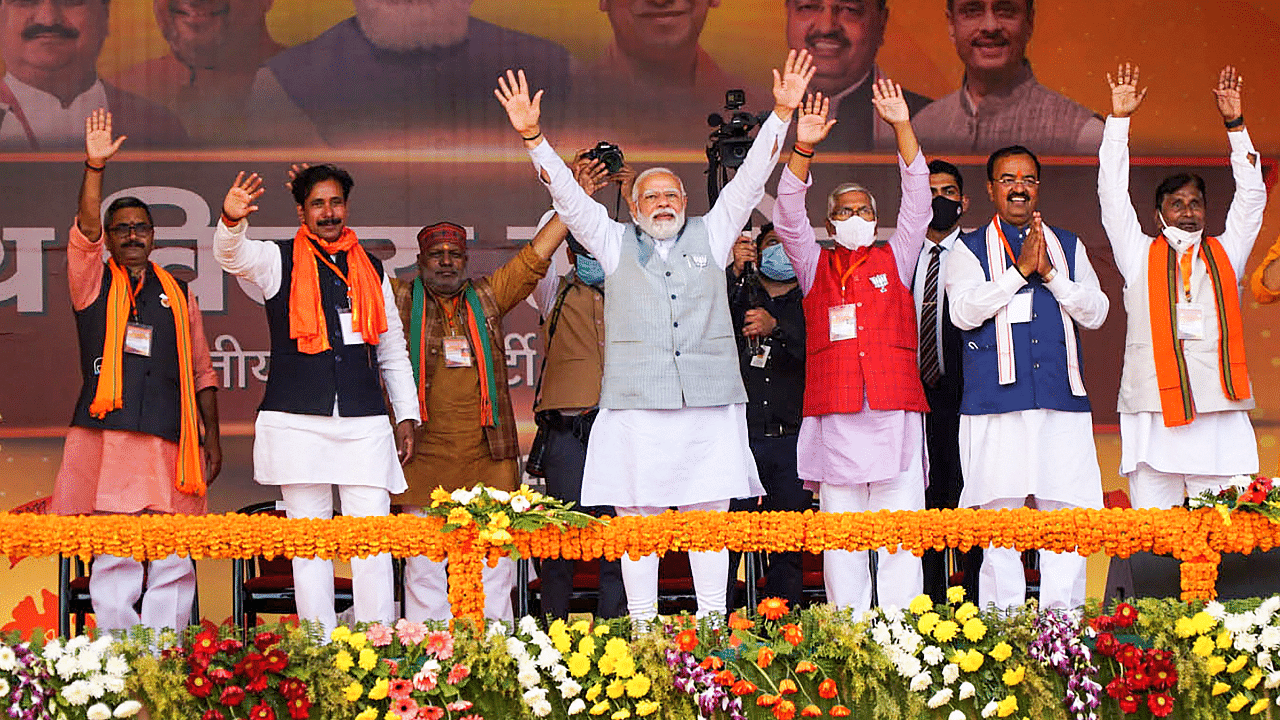
Bhartiya Janata Party (BJP) insiders have started conceding that the ruling party's tally is bound to fall in the current election compared to where it stood in 2017. The big question is whether the numbers could come so drastically down that it will give way to its key rival, the Samajwadi Party (SP).
The BJP and SP agree the battle is brutal. Just as it is not easy for the BJP to retain its all-time high 2017 tally of 312 in the 403-member UP assembly, so is it no mean task for the SP to swing an increase from its low count of 47 (in 2017) to the majority mark of 202 to form the government in Lucknow.
"You can only come down after climbing Mount Everest," the BJP's state general secretary Vijay Pathak said. He is, however, confident. "It could turn out to be a tight finish, but we will form the government." According to Pathak, "Yogi Adotyanath will break the old jinx that no chief minister of the state has ever repeated a term in office."
Chief Minister Adityanath has proclaimed this vociferously during the poll campaign even as it is widely believed there is anti-incumbency against his government. However, the anti-incumbency is perceived to be not so much against the BJP as it is against Adityanath. There is a view that it would have been easier for the BJP to sail through if it had fought exclusively on prime minister Narendra Modi's face.
No wonder after the fifth phase concluded on February 27, with 292 seats having already polled, UP is busy debating whether the BJP will rewrite history or the SP will decide the political destiny of the country's most populous state. It is, therefore, no surprise that Modi has finally decided to camp in Varanasi for three days to try and turn the tide now.
The SP's visibly rising response at the ground level might be a pleasant surprise to its leader, former chief minister, Akhilesh Yadav, who was perhaps some months back not that hopeful of putting up a fight against the might of the BJP. But what appears apparent is the jolt that the BJP seems to be getting with every election phase. It has brought to the fore the desperation of its top leaders, which could be discerned from their changing utterances over the past few weeks.
The BJP did play its masterstrokes – the Hindutva card to stoke the Hindu-Muslim divide; Ayodhya temple to impress its Hindu vote bank; free rations to win the poor and its half-truth narratives on law and order or women's security. To top it all, the party's battery of star campaigners led by none other than Prime Minister Narendra Modi left no stone unturned to throw a super challenge to Akhilesh Yadav, who had to run his campaign single-handedly for the first time in his political career.
Yet, there is little doubt that from the early stages of the poll campaign, with Rashtriya Lok Dal (RLD) chief Jayant Chaudhary alongside him in West UP to the ongoing final phases in East UP, the SP chief has grown in stature, maturity and confidence.
The BJP's strategy to stir the communal divide in West UP failed because of the overriding effect of the year-long farmers' movement that brought the earlier warring Jats and Muslims under a common umbrella. The ploy failed even in central UP and Avadh regions. So the BJP sought to play up the "law and order", and "women security" issues, which they alleged were under serious threat during the previous SP regime. Although he began a tad late in the day, Akhilesh Yadav aggressively countered the two issues and was joined by SP Rajya Sabha MP, Hindi movies actor Jaya Bachchan, and his wife, former Lok Sabha MP, Dimple Yadav.
The BJP did its best to switch its focus on "free rations" in the poverty-ridden Purvanchal region of UP, where it hopes to turn the tide that seems to have gone against it in the previous four phases. But here, the saffron brigade found a formidable wall built by Akhilesh Yadav through the multiple alliances he successfully stitched with smaller non-Yadav OBC groups. Significantly, some of these very non-Yadav OBCs were wooed by Modi right from 2014, and they paid rich political dividends to the BJP in 2017 and 2019. But Adityanath's blatant pro-Thakur attitude left several leaders of these very non-Yadav OBCs disillusioned with the party.
The exit of three prominent OBC ministers – Swami Prasad Maurya, Dara Singh Chauhan and Dharam Singh Saini – from the Adityanath cabinet and their instant entry into the SP at the beginning of the elections dealt the BJP its most significant blow. Along with the three, as many as a dozen BJP MLAs also switched parties to the SP. This force of non-Yadav OBCs has added much strength to the SP in the heavily caste-oriented politics of the Purvanchal region, where the battle began in the fifth phase.
The remaining two phases of polling, primarily limited to this region, are unlikely to enable the BJP any giant leap without which it may lag in the final race to power.
(Sharat Pradhan is a journalist and an author based in Lucknow.